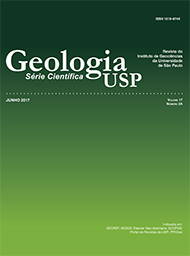Thermal modeling of a metamorphic aureole around a paleogene hypabissal basic intrusion within the Potiguar Basin, Northeast of Brazil
DOI:
https://doi.org/10.11606/issn.2316-9095.v17-362Keywords:
Pyrometamorphism, Petrophysics, Potiguar Basin, NE Brazil.Abstract
The Potiguar Basin encompasses a considerable volume of alkaline basic rocks. The thermal effects associated with the emplacement of igneous rocks on sedimentary sequences can cause a peculiar type of contact metamorphism, the pyrometamorphism, which produces partial melting of host rocks and generate new rocks. This paper discusses the thermal effects caused by Cenozoic intrusions, known as Macau Magmatism, over Cretaceous rocks of the Potiguar Basin by means of field, petrographic and petrophysical data. Using mathematical models, the thermal cooling was simulated in the proximity of the São João plug, northeastern of Pedro Avelino village (state of Rio Grande do Norte, NE, Brazil). The results were correlated with mineralogical changes in the surrounding rocks. The most significant physical and textural changes from high to low temperatures are partial melting and recrystallization, compression and hydraulic fracturing. The thermal modeling indicates that the metamorphic aureole can reach up to 150 m from the contact. In addition, mineral assemblages related to contact metamorphism (cordierite, tridymite, spurrite, besides glass) allow to estimate minimum temperature conditions of the order of 1,000 °C and pressure of 0.5 kbar. Thermal modeling suggests that mineralogical and textural changes were effective for temperatures above 400 °C. The estimate for the São João plug cooling time is about 10,000 years. These data are relevant in order to understand the effect of magmatism on the remobilization of hydrocarbons and its influence on the Potiguar Basin petroliferous systems.
Downloads
Downloads
Published
Issue
Section
License
Authors who publish in this journal shall comply with the following terms:
- Authors keep their copyright and grant to Geologia USP: Série Científica the right of first publication, with the paper under the Creative Commons BY-NC-SA license (summary of the license: https://creativecommons.org/licenses/by-nc-sa/4.0 | full text of the license: https://creativecommons.org/licenses/by-nc-sa/4.0/legalcode) that allows the non-commercial sharing of the paper and granting the proper copyrights of the first publication in this journal.
- Authors are authorized to take additional contracts separately, for non-exclusive distribution of the version of the paper published in this journal (publish in institutional repository or as a book chapter), granting the proper copyrights of first publication in this journal.
- Authors are allowed and encouraged to publish and distribute their paper online (in institutional repositories or their personal page) at any point before or during the editorial process, since this can generate productive changes as well as increase the impact and citation of the published paper (See The effect of Open Access and downloads on citation impact).





